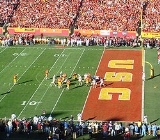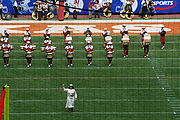
End zone
Encyclopedia


Gridiron football
Gridiron football , sometimes known as North American football, is an umbrella term for related codes of football primarily played in the United States and Canada. The predominant forms of gridiron football are American football and Canadian football...
, the end zone refers to the scoring area
Goal (sport)
Goal refers to a method of scoring in many sports. It can also refer to the physical structure or area of the playing surface where scoring occurs....
on the field. It is the area between the end line and goal line bounded by the sidelines
Sidelines
The "sidelines" is a term commonly used to define the white or colored lines which mark the outer boundaries of a sports field. American football sidelines, for example, mark the edge of the field. Should a player pass through the sidelines, he is considered out of bounds...
. There are two end zones, each being on an opposite side of the field. It is bordered on all sides by a white line indicating its beginning and end points, with orange, square pylons placed at each of the four corners as a visual aid. Canadian rule books use the term goal area instead of end zone, but the latter term is the more common in colloquial Canadian English. Unlike sports like Association football and ice hockey
Ice hockey
Ice hockey, often referred to as hockey, is a team sport played on ice, in which skaters use wooden or composite sticks to shoot a hard rubber puck into their opponent's net. The game is played between two teams of six players each. Five members of each team skate up and down the ice trying to take...
which require the puck or ball to pass completely over the goal line to count as a score, both Canadian and American football just merely need the nose of the ball to break the vertical plane of the outer edge of the goal line.
A similar concept exists in both rugby football
Rugby football
Rugby football is a style of football named after Rugby School in the United Kingdom. It is seen most prominently in two current sports, rugby league and rugby union.-History:...
codes, where it is known as the in-goal area. The difference between rugby and gridiron-based codes is that in rugby, the ball must be touched to the ground in the in-goal area to count as a try
Try
A try is the major way of scoring points in rugby league and rugby union football. A try is scored by grounding the ball in the opposition's in-goal area...
(the rugby equivalent of a touchdown), whereas in the gridiron-based games, simply possessing the ball while it is in the end zone is sufficient to count it as a touchdown.
History
The end zones were invented as a result of the creation of the forward passForward pass
In several forms of football a forward pass is when the ball is thrown in the direction that the offensive team is trying to move, towards the defensive team's goal line...
. Prior to this, the goal line and end line were the same, and players scored a touchdown by leaving the field of play through that line. Goal posts were placed on the goal line, and any kicks that did not result in field goals but left the field through the end lines were simply recorded as touchback
Touchback
In American football, a touchback is a ruling which is made and signaled by an official when the ball becomes dead behind or above a goal line and the team who is attacking that goal line is responsible for the ball being there. Responsibility is determined by which team gave the ball the impetus...
s (or, in the Canadian game, singles
Single (football)
In Canadian football, a single is awarded when the ball is kicked into the end zone by any legal means, other than a successful field goal, and the receiving team does not return, or kick, the ball out of its end zone...
; it was during the pre-end zone era that Hugh Gall
Hugh Gall
Hugh Gall was a Canadian football player considered to be one of the best runners and punters of his era.After playing half-back in Toronto for Parkdale Collegiate, Gall joined the University of Toronto varsity team in 1907 and played there for four seasons...
set the record for most singles in a game, with 8).
In the earliest days of the forward pass, the pass would have to be caught in-bounds, and could not be thrown across the goal line (as the receiver would be out of bounds). This also made it difficult to pass the ball when very close to one's own end zone, since merely dropping back to pass or kick would result in a safety (rules of the forward pass at the time required the passer to be five yards behind the line of scrimmage, which would make throwing the forward pass when the ball was snapped from behind one's own five-yard line illegal in itself). Thus, in 1912, the end zone was born. Each league used a different approach: Canadian football
Canadian football
Canadian football is a form of gridiron football played exclusively in Canada in which two teams of 12 players each compete for territorial control of a field of play long and wide attempting to advance a pointed prolate spheroid ball into the opposing team's scoring area...
, which adopted the forward pass and the end zones in 1929 (far later than the Americans), merely appended 20- to 25-yard end zones to the ends of the existing 110-yard field, leaving the goal posts on the goal line and creating a much larger field of play. American football
American football
American football is a sport played between two teams of eleven with the objective of scoring points by advancing the ball into the opposing team's end zone. Known in the United States simply as football, it may also be referred to informally as gridiron football. The ball can be advanced by...
, on the other hand, took a different approach: 12 yards of end zone were added to each end of the field, but in return, the playing field was shortened from 110 yards to 100, resulting in the physical size of the field being only slightly longer than before. Goal posts were originally kept on the goal lines, but after they began to interfere with play, they moved back to the end lines in 1927, where they have remained in college football ever since. The National Football League moved the goal posts up to the goal line again in 1932, then back again to the end line in 1974.
Scoring
A team scores a touchdownTouchdown
A touchdown is a means of scoring in American and Canadian football. Whether running, passing, returning a kickoff or punt, or recovering a turnover, a team scores a touchdown by advancing the ball into the opponent's end zone.-Description:...
by entering its opponent's end zone while carrying the ball or catching the ball while being within the end zone. If the ball is carried by an offensive player across the goal line, it is considered a score as soon as the ball crosses the goal line between the pylons. In addition, a two-point conversion
Two-point conversion
In American and Canadian football, a two-point conversion is a play a team attempts instead of kicking a one-point convert immediately after it scores a touchdown...
may be scored after a touchdown by similar means. The National Football League changed its rule in 2007, so that a ball carrier merely touching the pylon is insufficient to score a touchdown; the ball must actually enter the end zone.
Size
The end zone in Canadian footballCanadian football
Canadian football is a form of gridiron football played exclusively in Canada in which two teams of 12 players each compete for territorial control of a field of play long and wide attempting to advance a pointed prolate spheroid ball into the opposing team's scoring area...
is 20 yards long by 65 yards wide, while the end zone in American football is 10 yards long by 53⅓ yards wide (Canadian football is played on a longer and wider field). The end zone stretches from pylon to pylon on an American football field.
The goal post
The location and dimensions of a goal post differs from league to league, but it is always within the boundaries of the end zone. In earlier football games (both professional and collegiate), the goal post began at the goal line, and was usually an H-shaped bar. Nowadays, for player safety reasons, almost all goal posts in the professional and collegiate levels of American football are T-shaped, and reside just outside the rear of both end zones.The goal posts in Canadian football still reside on the goal line instead of the back of the end zones, partly because the number field goal attempts would dramatically decrease if the posts were moved 20 yards back in that sport.
Decoration
Most professional and collegiate teams have their logoLogo
A logo is a graphic mark or emblem commonly used by commercial enterprises, organizations and even individuals to aid and promote instant public recognition...
, team name, or both painted on the surface of the end zone, with team colors filling the background. Many championship and bowl games at college and professional level are commemorated by the names of the opposing teams each being painted in one of the opposite end zones.
In many places, particularly in smaller high schools and colleges, end zones are undecorated, or have plain white diagonal stripes spaced several yards apart, in lieu of colors and decorations.

